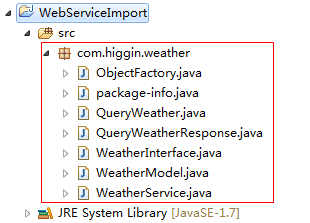【服务端】
第一步:建立一个Web项目
第二步:填充CXF jar包
第三步:创建接口及服务类
【工程截图(对比之前的WebService_CXF_Server00)】
【applicationContext.xml】
<?xml version="1.0" encoding="UTF-8"?> <beans xmlns="http://www.springframework.org/schema/beans" xmlns:xsi="http://www.w3.org/2001/XMLSchema-instance" xmlns:jaxws="http://cxf.apache.org/jaxws" xmlns:jaxrs="http://cxf.apache.org/jaxrs" xmlns:cxf="http://cxf.apache.org/core" xsi:schemaLocation="http://www.springframework.org/schema/beans http://www.springframework.org/schema/beans/spring-beans.xsd http://cxf.apache.org/jaxrs http://cxf.apache.org/schemas/jaxrs.xsd http://cxf.apache.org/jaxws http://cxf.apache.org/schemas/jaxws.xsd http://cxf.apache.org/core http://cxf.apache.org/schemas/core.xsd"> <!-- service --> <bean id="weatherInterface" class="com.Higgin.ws.service.WeatherInterfaceImpl"></bean> <!-- 发布服务 使用jaxws:server和jaxws:endpoint可以发布服务 WebService地址=Tomcat地址值+CXF Servlet的路径+ /weather --> <jaxws:server address="/weather" serviceClass="com.Higgin.ws.service.WeatherInterface"> <jaxws:serviceBean> <ref bean="weatherInterface"/> </jaxws:serviceBean> </jaxws:server>
</beans>
【web.xml】
<?xml version="1.0" encoding="UTF-8"?> <web-app xmlns:xsi="http://www.w3.org/2001/XMLSchema-instance" xmlns="http://java.sun.com/xml/ns/javaee" xsi:schemaLocation="http://java.sun.com/xml/ns/javaee http://java.sun.com/xml/ns/javaee/web-app_3_0.xsd" id="WebApp_ID" version="3.0"> <display-name>WebService_CXF_Spring_Server00</display-name> <welcome-file-list> <welcome-file>index.jsp</welcome-file> </welcome-file-list> <!-- 加载Spring容器 --> <context-param> <param-name>contextConfigLocation</param-name> <param-value>/WEB-INF/classes/applicationContext.xml</param-value> </context-param> <listener> <listener-class>org.springframework.web.context.ContextLoaderListener</listener-class> </listener> <!-- CXF的Servlet --> <servlet> <servlet-name>cxf</servlet-name> <servlet-class>org.apache.cxf.transport.servlet.CXFServlet</servlet-class> <load-on-startup>1</load-on-startup> </servlet> <!-- 本系统的WebService路径必须以/ws/开头 --> <servlet-mapping> <servlet-name>cxf</servlet-name> <url-pattern>/ws/*</url-pattern> </servlet-mapping> </web-app>
【启动Web容器】
访问 http://localhost:8080/WebService_CXF_Spring_Server00/ws

接着访问 http://localhost:8080/WebService_CXF_Spring_Server00/ws/weather?wsdl

可见WebService服务端启动正常。
【测试注意】
因为Spring和CXF整合将WebService通过TomCat发布,WebService和应用程序共用一个端口是8080。
测试WebService和应用程序(JSP)是否可以共存(都可以访问)
正式上线使用80端口。
【客户端】
【生成客户端代码】
首先,使用利用WebService的wsdl2java工具生成客户端代码:


【客户端工程截图】

【applicationContext.java】
<?xml version="1.0" encoding="UTF-8"?> <beans xmlns="http://www.springframework.org/schema/beans" xmlns:xsi="http://www.w3.org/2001/XMLSchema-instance" xmlns:jaxws="http://cxf.apache.org/jaxws" xmlns:jaxrs="http://cxf.apache.org/jaxrs" xmlns:cxf="http://cxf.apache.org/core" xsi:schemaLocation="http://www.springframework.org/schema/beans http://www.springframework.org/schema/beans/spring-beans.xsd http://cxf.apache.org/jaxrs http://cxf.apache.org/schemas/jaxrs.xsd http://cxf.apache.org/jaxws http://cxf.apache.org/schemas/jaxws.xsd http://cxf.apache.org/core http://cxf.apache.org/schemas/core.xsd"> <!-- 使用<jaxws:clietn>调用服务端 jaxws:client内部使用JaxWsProxyFactoryBean方式 serviceClass:指定portType地址(需要使用wsdl2java工具生成) --> <jaxws:client id="weatherClient" address="http://localhost:8080/WebService_CXF_Spring_Server00/ws/weather?wsdl" serviceClass="com.higgin.weather.WeatherInterface"> </jaxws:client> </beans>
【ClientTest.java】
package com.higgin.ws.cxf; import java.text.SimpleDateFormat; import java.util.Date; import java.util.List; import org.junit.Before; import org.junit.Test; import org.springframework.context.ApplicationContext; import org.springframework.context.support.ClassPathXmlApplicationContext; import com.higgin.weather.WeatherInterface; import com.higgin.weather.WeatherModel; public class ClientTest { private ApplicationContext applicationContext; @Before public void before(){ applicationContext=new ClassPathXmlApplicationContext("applicationContext.xml"); } @Test public void testCxfSpringClient(){ //从Spring容器中取出portType WeatherInterface weatherInterface=(WeatherInterface) applicationContext.getBean("weatherClient"); //调用portType方法 List<WeatherModel> list=weatherInterface.queryWeather("杭州"); for(WeatherModel weatherModel:list){ System.out.println(weatherModel.getDetail()); Date date=weatherModel.getDate().toGregorianCalendar().getTime(); System.out.println(new SimpleDateFormat("yyyy-MM-dd").format(date)); System.out.println(weatherModel.getTemperatureMax()); System.out.println(weatherModel.getTemperatureMin()); } } }
【运行结果】

【总结:使用jaxws实现SOAP1.1、SOAP1.2】
方式一:
CXF编程实现:
1.使用jaxwsServerFactoryBean发布WebService服务端。
需要设置:
jaxwsServerFactoryBean.setAddress("WebService地址");
jaxwsServerFactoryBean.setServiceClass("porType类路径"); //由程序员编写的
jaxwsServerFactoryBean.setServiceBean("portType类对象");
jaxwsServerFactoryBean.create(); //发布一个服务
2.使用jaxwsProxyFactory实现客户端调用WebService服务
jaxwsServerFactoryBean.setAddress("WebService的wsdl地址");
jaxwsServerFactoryBean.setServiceClass("portType路径"); //portType是wsdl2java工具生成
jaxwsServerFactoryBean.setCreate(); //创建portType对象
方法二:
CXF和Spring整合开发服务端和客户端。
1.使用<jaxws:Server>发布WebService服务端
在<jaxws:Server>设置Address、serviceClass、serviceBean
2.使用<jaxws:Client>调用WebService服务
在<jaxws:Server>设置Address、serviceClass